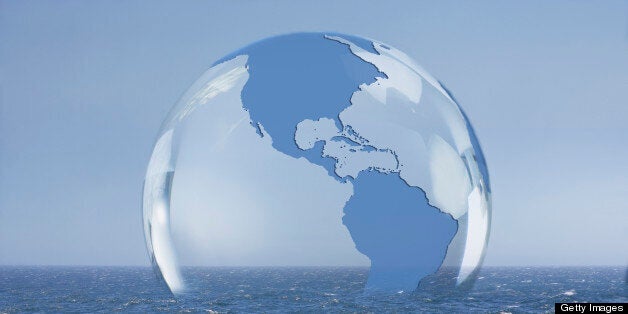
Co-authored by William Blakemore
In a recent blog post, Secretary of State John Kerry described climate change as a "gathering storm," already affecting millions around the world and posing direct challenges to our national security and global stability. In a new report, the Pentagon agreed. Indeed, our climate is changing in erratic but decisive ways, as the ice caps melt, seas warm (and rise), and the temperature of the globe increases over time. Diverse disciplines offer perspectives on these issues that could lead to our deeper understanding -- and mitigation. We seek to contribute by asking how these changes relate to geopolitical violence and terrorism, especially in the world's most unstable regions.
One of those regions is the Middle East. In a September 29 post titled "How Climate Change Helped ISIS," we explored connections between a catastrophic, poverty-inducing drought and the rise of militant Jihadis in Syria, including ISIS (also known as ISIL or the Islamic State). The drought lasted from 2006 to 2010 and devastated the livelihoods of an estimated 800,000 farmers and herders. Syrians struggled with malnutrition, increased school drop-out rates, and migrations to overcrowded urban areas. While millions suffered because of the drought, Bashar al-Assad's corrupt government provided little relief. The resulting rage helped to trigger the 2011 uprising. In the power vacuum of Syria's ongoing civil war, ISIS found a haven from which to emerge in its current form: a quasi-military force and self-proclaimed caliphate, committing horrific atrocities across large swathes of conquered territory.
Thousands of miles away, in South Asia, Bangladesh provides another example worth contemplating. Unlike Syria, Bangladesh is not currently in full crisis. But the fault lines of its environmental, economic, and sociopolitical vulnerabilities are becoming increasingly clear.
Bangladesh packs 160 million people into an area roughly the size of Iowa, with most of its territory lying just above sea level. Located on the world's largest river delta, Bangladesh has long been prone to natural disasters, including widespread seasonal flooding, cyclones and storm surges, riverbank erosion, droughts, tornados, landslides, and earthquakes. The effects of climate change are projected to intensify those hazards. Scientists predict that rising seas will submerge roughly 17 percent of Bangladesh's land and displace 18 to 20 million of its people during the current century. Rising seas also raise salinity levels, threatening agriculture, food supplies, and freshwater availability. And more intense cyclones with heightened storm surges threaten to increase already staggering death tolls and devastation from frequently striking storms.
Bangladesh's sociopolitical and economic conditions are similarly precarious. Bangladesh plays a key role in regional stability, but is also a young and fragile democracy. The country stands at a crossroads, struggling with pervasive poverty, corruption, religious extremism, and issues of national identity. In recent years, Bangladesh has made great strides toward reducing poverty, simultaneously increasing life expectancy and displaying strong economic growth; yet poverty remains widespread. The country's political system is troubled, with the relationship of its two major parties characterized by deadlock and animosity that has often bred violence. Early this year, clashes and attacks marred national elections following the main opposition party's boycott.
Religiously, Bangladesh generally identifies as a tolerant, Sunni Muslim-majority nation. Yet a rising tide of religious conservatism has emerged, with elements of Islamism gaining traction and some calling for the imposition of Sharia law. Extremist organizations operate with varying degrees of openness; several are banned officially. Groups with a notable presence include Jamaat-e-Islami, a fundamentalist party banned from elections in 2013; Hefazat-e-Islam, a madrassa-based coalition; Harkat-ul Jihad al-Islami (HuJI), established in Bangladesh in 1992, reportedly with support from Osama bin Laden; Hizb ut-Tahrir; Ansarullah Bangla Team; and numerous others. Recently, regional efforts to recruit for ISIS have made headlines, including the September arrest of a British man in Bangladesh's capital, Dhaka, on suspicion of recruiting for ISIS and the Nusra Front. With Bangladesh struggling to define its identity, the impacts of further environmental disasters could inflame regional tensions and provide extremists and cross-border terrorist networks with more opportunities to thrive.
Bangladesh's recent past is instructive. It has experienced already one instance of the sequence of events with which we are concerned: a major weather catastrophe, resulting in collective psychological and economic trauma, and consequent violence on a major scale. The Bhola Cyclone of November 1970 slammed into Bangladesh (then East Pakistan) with devastating power that killed up to half a million people -- making it the world's deadliest recorded cyclone. A 20-foot storm surge, accompanied by winds of 150 miles per hour, inundated low-lying islands, wiped out hundreds of villages, and destroyed crops across the region. The Pakistani government's weak response and apparent indifference greatly intensified Bengali unrest under Pakistani rule. In the ensuing elections, the opposition party surged to victory on a platform of greater autonomy. Disagreements over implementing election results erupted into the full-blown violence of Bangladesh's liberation war.
Pakistani forces cracked down on those promoting self-determination, and ultimately committed a tragic genocide, still too little known in the West, against the Bengali people. Estimates of the death toll vary widely, ranging up to 3 million. Pakistani and affiliated forces systematically raped approximately 200,000 women, and roughly 10 million refugees flooded across the border to India. India resolved to support the Bengalis, and in 1971, its military became decisively involved in a war with Pakistan that led to the creation of Bangladesh.
The four decades since Bangladesh's liberation war have seen increasing tension and violence between Bangladesh and its Indian liberators along social, economic, and religious lines. India has constructed a 2,000-mile barbed wire fence along most of its border with Bangladesh as a physical barrier against "climate refugees" (and smugglers). Armed clashes involving India's Border Security Force have brought repeated charges of indiscriminate killings, and the continuing pressure of Bangladeshis trying to escape sea-level villages, salinated fields, and overcrowded slums is only expected to increase as the water rises.
This sequence from environmental disaster to terrorism, war, and genocide persists as a threat on the subcontinent. And it could all unfold in a region with unstable democracies brimming with nuclear weapons.
William Blakemore is a veteran foreign and domestic correspondent. He covered a dozen major conflicts for ABC News in the Mideast and the Subcontinent including the 1971 Bangladesh War, the 1991 and 2003 Iraq wars and the ongoing Afghan-Taliban war. On 9/11 he reached Ground Zero before the towers fell. He also traveled with Pope John Paul II and authored the Encyclopaedia Britannica article about him. He has won many major broadcast journalism awards, and began focusing on global warming in 2004. Now freelance, he also lectures on the journalistic profession, "The Many Psychologies of Global Warming," and the cinematic art of Stanley Kubrick.
